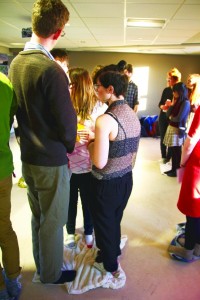 When students and community members first walked into the room, blankets of various colours, patterns and shapes were laid out in no particular order on the floor, slightly off centre. The narrators, three members of Canadian Roots Exchange, invited everyone to stand on the blankets. Participants were told they were standing on land initially inhabited by Canada’s aboriginal peoples, before the arrival of European settlers.
When students and community members first walked into the room, blankets of various colours, patterns and shapes were laid out in no particular order on the floor, slightly off centre. The narrators, three members of Canadian Roots Exchange, invited everyone to stand on the blankets. Participants were told they were standing on land initially inhabited by Canada’s aboriginal peoples, before the arrival of European settlers.
Each blanket represented the territory occupied by a specific nation and participants represented members of that community. Your position within the blanket area also affected the outcome of the activity: those facing north, representing Canada’s Inuit populations, faced a different outcome than those facing west, representing the country’s Métis peoples. A number of participants were handed scrolls, written as fictitious first-hand accounts. Periodically read out loud, they added a personal aspect to the narrative.
At first, the narrators, playing the role of European settlers, spoke of collaboration between indigenous peoples and Europeans. But as the narrative progressed, land was gradually taken away and things looked increasingly bleak for Canada’s aboriginal populations. As the blankets became smaller, participants became increasingly isolated. Some were told to step off the blankets, while some were told to move in a completely separate portion of the room. There was no longer any talk of collaboration. Rather, aboriginals were dying of illnesses brought by Europeans and were taken away from their families to attend residential schools. At the end of the activity, there were about 10 participants left on the blankets. Everybody else had either died of an illness, had been taken away, or had decided to move out of the reserve.
“Even if [participants] do know about the history [of indigenous relations], they still come out pretty shocked, just feeling heavy and guilty,” said Killa Atencio, a member of Canadian Roots Exchange. Atencio, a resident of Listuguj, Que., was one of three representatives from Canadian Roots Exchange.
The blanket exercise, held on Friday, Jan. 23, was developed by KAIROS, a Canadian faith based humanitarian organization. It aims to demonstrate through the use of blankets Canada’s colonial history and the evolution of our relationship with Aboriginal Peoples.
“It hits home for me because I understand, that’s the kind of environment I grew up in. The stories aren’t news to me,” said Emma Hassencahl, a member of the Aboriginal Support Group and resident of the Tobique Band.
A debriefing session followed the exercise, where all participants, sitting in a circle, had a chance to share their thoughts on what they had just experienced.
“The activity was very emotionally powerful. It was so different than learning it in a textbook in school, because you actually felt these emotions,” said Sébastien Engelmann, a third-year student. “It brought those things to life and that was really interesting, just to see how everything was taken away from us so quickly and then very little was gained back. It didn’t seem right what was given back,” said Engelmann.
Mount Allison’s Aboriginal Support Group organized the activity in collaboration with Mount Allison’s Centre for International Studies. About 30 people attended the exercise.
Organizers were pleased with the turnout.
“It’s really nice to see a big group of people, because you can separate the [blankets] more, which causes more of an impact when you see three people taken away as opposed to just one,” said Atencio.
Canadian Roots Exchange’s mission is to “build bridges between Indigenous and non-Indigenous youth in Canada by facilitating dialogue and strengthening relationships through leadership programs.” The organization’s teams travel all across Canada to host events like the blanket exercise and are made of both indigenous and non-indigenous peoples.





